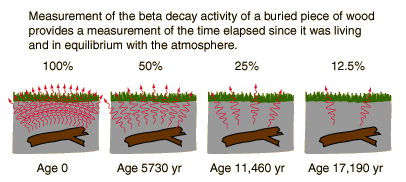No folks Aftermath hasn’t entered the matchmaking business but remains your ever so humble science e-magazine. This article is actually based on the ingenious method that tells you the age of a host of things from a mummy to a dinosaur bone or perhaps the age of the antique clay pot on your display shelf. This scientific process is known as radiometric / radioactive dating. There are number of types of dating from uranium dating to C-14 dating. They are categorized by the time period to which they can reliably confirm dates of objects, formation of geological features or even bodies of ancient people. The C-14 dating was the first convincing dating procedures that worked on matter which was once living. The method was developed immediately following World War II by Willard F. Libby and coworkers, and has provided age determinations in archaeology, geology, geophysics and other branches of science. Radiocarbon determinations can be obtained on wood; charcoal; marine and fresh-water shell; bone and antler; peat and organic-bearing sediments, carbonate deposits such as tufa, caliche, and marl; and dissolved carbon dioxide and carbonates in ocean, lake and ground-water sources.
C-14 is created when cosmic rays from the far reaches of space strike nuclei to produce neutrons; these in turn bombard nitrogen atoms to produce C-14. This C-14 is radio active in nature and combines with oxygen in the atmosphere to form CO2 and thus enter our living cycle.
Archaeologists and scientists use this radioactive quality to their advantage by measuring the activity from the sample substance and
comparing it to the equilibrium level of living things they can determine the time that has passed. Since all life on Earth is made of organic molecules that contain carbon atoms derived from the atmosphere, all living things have about the same ratio of C-14 atoms to other carbon atoms in their tissues.
Once an organism dies it stops taking in carbon in any form, and the C-14 already present begins to decay. Over time the amount of C-14 present in the material decreases, and the ratio of C-14 to other carbon atoms declines. In terms of radio carbon dating the fewer C-14 atoms in the sample the older the sample is. The rate of decay of C-14 is pretty steady.
The half life of C-14 is 5730 years. What this means is that half of the C-14 has decayed after 5730 years. Then half of the remaining C-14 or one fourth of the original amount decays in the next 5730 years. After about 50,000 years the amount of C-14 still present in the sample becomes immeasurable. Carbon-14 decays with a half life of about 5730 years by the emission of an electron of energy 0.016 MeV. This changes the atomic number of the nucleus to 7, producing a nucleus of nitrogen-14. At equilibrium with the atmosphere, a gram of carbon shows an activity of about 15 decays per minute.
The low activity of the carbon-14 limits age determinations to the order of 50,000 years by counting techniques. That can be extended to perhaps 100,000 years by accelerator techniques for counting the carbon-14 concentration.
The accelerator technique works with the help of a cyclotron accelerator working in unison with mass spectrometers .
While radiocarbon dating is a good method of dating fairly recent prehistoric objects, other techniques must be used to date materials older than 50,000 years. These methods include other absolute dating techniques that are similar to C-14 dating methods. Elements other than C-14 can be used in absolute dating techniques.
In this list of radioactive dating processes are:
Samarium-neodymium dating method
This involves the Alpha-decay of 147Sm to 143Nd with a half life of 1.06 x 10^11 years. Accuracy levels of less than twenty million years in two-and-a-half billion years are achievable.
Potassium-argon dating method
This involves electron capture or positron decay of potassium-40 to argon-40. Potassium-40 has a half-life of 1.3 billion years, and so this method is applicable to the oldest rocks. Radioactive potassium-40 is common in micas, feldspars, and hornblendes, though the blocking temperature is fairly low in these materials, about 125°C (mica) to 450°C (hornblende).
Rubidium-strontium dating method
This is based on the beta decay of rubidium-87 to strontium-87, with a half-life of 50 billion years. This scheme is used to date old igneous and metamorphic rocks, and has also been used to date lunar samples. Blocking temperatures are so high that they are not a concern. Rubidium-strontium dating is not as precise as the uranium-lead method, with errors of 30 to 50 million years for a 3-billion-year-old sample.
Uranium-thorium dating method
A relatively short-range dating technique is based on the decay of uranium-238 into thorium-230, a substance with a half-life of about 80,000 years. It is accompanied by a sister process, in which uranium-235 decays into protactinium-231, which has a half-life of 34,300 years.
While uranium is water-soluble, thorium and protactinium are not, and so they are selectively precipitated into ocean-floor sediments, from which their ratios are measured. The scheme has a range of several hundred thousand years.
These dating techniques can’t exactly pinpoint the date an event occurred. But they can give us a close approximation as to when the event might have taken place. So now u too have learnt the way to get the perfect date.
----
By Tahsin Uddin Mullick
North South University, Dhaka, Bangladesh
----
The Aftermath Publications, Issue 2
----
Saturday, January 17, 2009
Subscribe to:
Post Comments (Atom)














No comments:
Post a Comment
Please comment and question about the content of the post.